Create a Vibrant Autumn in Your Own Backyard
Story and photos by Victoria LaubachTrees and shrubs for autumn color
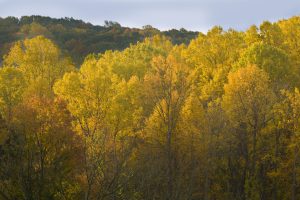
Now that summer has faded and days continue to grow shorter and temperatures cooler, it won’t be long until we experience the glorious colors of fall. Whether our area has an awesome autumn color display depends to a great extent on the weather — warm sunny days and cool, not-freezing nights — along with the right soil moisture making the difference between an intense, brilliant display or one that’s merely ho-hum.
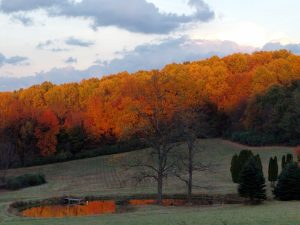
While many people travel to other regions to leaf-peep (we’re talking about you, New England), our local forests offer vibrant shades of orange and red from maples, yellow to gold to brown from tulip poplars, hickories, oaks and beeches. You can create your own displays of fall color in your garden by choosing native trees and shrubs — whether it’s a specimen tree, needing significant space to grow, or small to medium-sized trees and shrubs that can add autumn color interest to your garden.
Here are some recommendations, many of which you can see at Welkinweir.
Trees for Autumn Color
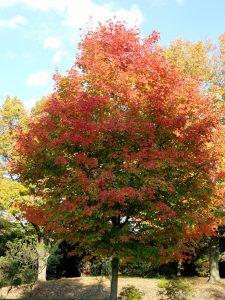
The quintessential tree of autumn with its blazing gold and orange leaves is the sugar maple (Acer saccharum). These trees are found at higher elevations, where temperatures are cooler. But there are a few selections of sugar maple that do well in our heat and humidity, including Green Mountain and Autumn Splendor. Local forests boast resident red maples (Acer rubrum), brilliant in shades of red and orange. The varieties Red Sunset and October Glory offer exceptional fall color.
Tupelo (Nyssa sylvatica, of tupelo honey, a specialty honey of the South, as well as a Van Morrison song) produces fruits that are an important food source for migrating birds and offers spectacular fall coloring of bright scarlet. The Wildfire variety adds ruby red new growth during the growing season. Bearing distinctive star-shaped leaves, sweet gum (Liquidambar styraciflua) is vivid in fall, ranging from red, orange and yellow to dark purple, all at the same time. The fruitless (no spiky gumballs!) Rotundiloba with rounder leaves has burgundy fall color.
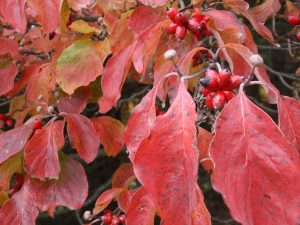
Sassafras (Sassafras albidum), which releases a spicy scent when any of the three different shaped leaves, twigs and roots are crushed, has a rainbow of fall colors, including yellow, orange, red and crimson. Blooming in fall, the American witch-hazel’s (Hamamelis virginiana) spidery yellow flowers often blooms alongside its yellow fall foliage. (Note: The astringent witch hazel is made from extracts of this native.)
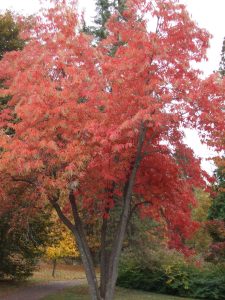
Two trees most associated with their spring floral displays — flowering dogwood and serviceberry — extend the season of interest with excellent fall foliage. Flowering dogwood’s (Cornus florida) foliage colors from red to burgundy along with bright red fruits (gobbled nearly immediately by birds). The serviceberry or juneberry (Amelanchier spp.), named for the delicious summer fruit, offers dramatic fire-engine red fall color, especially the variety Autumn Brilliance. Less well-known is sourwood (Oxydendrum arboretum), a small, slender, summer bloomer with intense orange to red fall color.
Shrubs for Color + Bonus Berries
There are many native shrubs that offer excellent fall color — rivaling the often-planted but highly invasive nonnative, burning bush (Euonymus alatus). Note: After January 2025, sales of burning bush will be banned in PA. Residents are encouraged to remove existing burning bush now. At Welkinweir, we’ve removed all the intentionally planted burning bush and continue to work to remove the seeded-in plants.
*For more on dealing with burning bush, see Aug. 2023 County Lines, “Plant This, Not That” by Kirsten Werner, Natural Lands.
Instead choose our native euonymus, eastern wahoo (Euonymus atropurpureus), with blazing fall color of its own. Blueberry is another excellent alternative with intense red to maroon fall color, plus delicious summer fruit, for you (or the birds). The color is shared by both the lowbush (Vaccinium angustifolium) and highbush blueberries (Vaccinium corymbosum), so there’s a blueberry sized for any garden.
A number of native viburnums offer multi-season interest, but there are two that are especially garden-worthy. The smooth viburnum (Viburnum nudum), Brandywine and Winterthur, have showy, glossy-green leaves changing to an incredible dark burgundy in autumn. White flowers are followed by attractive fruits clusters in shades of green, pink and blue as they ripen. Another viburnum, the American cranberry bush (Viburnum opulus var. americanum), is named for the edible cranberry-like bright red fruit clusters contrasting with scarlet to burgundy leaf color.
Chokeberries are multi-stem shrubs with red fall foliage and edible fruit used in jams, jellies, syrups and juice, as well as serving as food for birds and other wildlife. They are distinguished by their fruit color, red chokeberry (Aronia arbutifolia) and black chokeberry (Aronia melanocarpa).
The Virginia sweetspire (Itea virginia) Henry’s Garnet is a dependable, showy plant, with early summer white blooms attractive to pollinators and long-lasting foliage of varying shades of maroon, orange and gold.

Although technically southeast U.S. natives, fothergilla and oakleaf hydrangeas grow well in our area and are widely available at nurseries. Fothergillas are showy in the spring with honey-scented blooms, but are even showier in fall, with their breathtaking blend of orange, red, burgundy and yellow fall foliage — especially magnificent when planted in groups. White to pink conical summer blooms of oakleaf hydrangea are easily recognized by the large oak-shaped leaves and turn a consistent burgundy-red color.

As a side note, these native shrubs offer a showy display of berries in the fall and are worth seeking out. Beautyberry (Callicarpa Americana) produce clusters of iridescent purple berries that hug the branches and are Asian cousins of our native beautyberry. Suckering shrubs (Symphoricarpos), forming extensive colonies, can produce pinkish (S. orbiculatus) berries, coral berries or white (S. albus) berries, the snowberry.
So, although summer has drawn to a close (goodbye heat and humidity), your garden can still be as inspiring and colorful with the right selection of native trees and shrubs.
Welkinweir is a 224-acre arboretum and nature preserve, where history, horticulture and habitat meet. Located in East Nantmeal Township, 1368 Prizer Rd., Pottstown, Welkinweir is free and open Monday to Friday, 9 a.m. to 4:30 p.m. 610-469-7543; Welkinweir.org.
Our Favorite Resources
- B&D Builders
- Ball & Ball
- Berk Hathaway Holly Gross
- Berk Hathaway Kit Anstey
- Berk Hathaway M. Schwartz
- Canvas Valley Forge
- Dewson Construction
- DiSabatino Landscaping
- King Construction
- McComsey Builders
- Monument/Sotheby’s Int’l
- Mostardi Nursery
- Mountaintop Construction
- Renewal Dynamics
- Sheller Energy
- White Horse Construction
